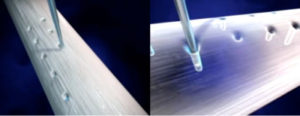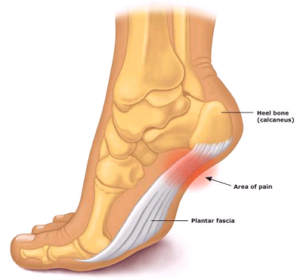Plantar fasciitis is the most common cause of foot pain (pain at the bottom of the heel). Approximately 2 million patients are treated for this condition every year. Plantar fasciitis occurs when the strong band of tissue that supports the arch of your foot becomes irritated and inflamed.
Clinical Assessment
After you describe your symptoms and discuss your concerns, your doctor will examine your foot. Your doctor will look for these signs:
- A high arch
- An area of maximum tenderness on the bottom of your foot, just in front of your heel bone
- Pain that gets worse when you move your ankle upwards and improves when you point your toes down
- Limited upwards motion of your ankle
Tests for Plantar Fasciitis
Your foot doctor may order imaging tests to help make sure your heel pain is caused by plantar fasciitis and not another problem.
X-rays
X-rays provide clear images of bones. They are useful in ruling out other causes of foot pain, such as fractures or arthritis. Heel spurs can be seen on an x-ray. Dr Victor Seah does not order xrays in clear cut cases of plantar fasciitis.
Other Imaging Tests
Other imaging tests, such as magnetic resonance imaging (MRI) and ultrasound, are not routinely used to diagnose plantar fasciitis. They are rarely ordered. An MRI scan may be used if the heel pain is not relieved by initial treatment methods.
Plantar Fasciitis Nonsurgical Treatment
More than 90% of patients with plantar fasciitis will improve within 10 months of starting simple treatment methods.
Rest
Rest can work like magic for plantar fasciitis sufferers, not to mention that this can also alleviate the pain and additional symptoms. If you practice intense physical activity, simply stop it for a while, until the condition improves
Ice
Ice packs are known to be of great help for those who suffer from plantar fasciitis – all you need is to apply a bottle of cold water or some ice packs on the foot for about twenty minutes. Repeat the treatment up to three times daily and you will notice considerable improvement.
Painkillers or Anti-inflammatory Drugs
NSAIDs can also come in handy for pain management and for reducing the inflammation. Nonetheless, consult with your health care provider prior to starting the treatment, especially if you are using it for more than 1 month.
Exercise
Plantar fasciitis is aggravated by tight muscles in your feet and calves. Avoid high impact exercises such as running and do plenty of stretches shown below.

Calf stretch
Simply stretch the calf muscles along with the heel cord by leaning against a wall and keeping one knee straight and the heels on the ground. Push your hips towards the wall and maintain the position for approximately 10 seconds. Twenty repetitions will do!
Plantar fascia stretch

Cortisone injections
Another popular and highly effective non-surgical treatment for plantar fasciitis is the injection with cortisone, a highly potent anti-inflammatory compound. The purpose of these injections is to reduce the pain and inflammation, although the patient can only take a certain number of injections – overusing them can lead to chronic pain. The shots must be performed by a medical professional.
Supportive shoes and orthotics

There are several types of supportive shoes that are especially created to provide extra support and cushioning while walking, so that the pain and inflammation are dramatically reduced. The purpose of these shoes is to reduce the tension on the fascia, thus alleviating the pain. These shoes usually come with silicone heel pads, but any type of custom made shoe inserts should do as long as they offer additional cushioning and improve comfort.
Radial shockwave therapy (RSWT)

RSWT is an acronym that stands for radial shockwave therapy and it is commonly used for the non-surgical treatment of plantar fasciitis. In a nutshell, this therapy involves shockwave impulses that stimulate the healing process and reduce pain. Patients usually require several treatment sessions on a weekly basis, depending on the severity of their plantar fasciitis. Short yet intense, the RSWT treatments last for about a quarter of an hour, they are non-invasive and they carry minimal risks. This is why they are a popular choice amongst those who suffer from this condition.
Surgical Treatment
Surgery is the last resort and considered only after 12 months of aggressive nonsurgical treatment.
Plantar fascia release
If you have a normal range of ankle motion and continued heel pain, your doctor may recommend a partial release procedure. During surgery, the plantar fascia ligament is partially cut to relieve tension in the tissue. If you have a large bone spur, it will be removed, as well. Although the surgery can be performed endoscopically, it is more difficult than with an open incision. In addition, endoscopy has a higher risk of nerve damage.
TOPAZ Therapy
The TOPAZ therapy is an option of last resort for plantar fasciitis sufferers – this is a minimally invasive surgery and it involves the use of Coblation technology.

The treatment involves creating a one-inch incision through which the TOPAZ MicroDebrider is introduced. The device is slowly inserted deeper into the fascia and it removes small amounts of tissue to trigger the body’s natural healing mechanism. The treatment involves local anesthesia and the patient can go home 1-2 hours after the treatment. There is minimal downtime and the patient can resume their normal daily activities very soon after the procedure.
Looking For A Reliable Foot & Ankle Orthopaedic Specialist?
Fast Medical Attention, Transparent Fees
Make an appointment for comprehensive care for your Foot & Ankle problems!

